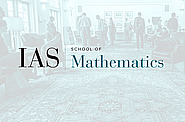Seminars
Nov
25
2014
Computer Science/Discrete Mathematics Seminar II
Sum-of-squares lower bounds for the planted clique problem
10:30am|S-101
Nov
24
2014
Computer Science/Discrete Mathematics Seminar I
Computational fair division
Ariel Procaccia
11:15am|S-101
Nov
18
2014
Computer Science/Discrete Mathematics Seminar II
Toric origami manifolds and origami templates
10:30am|S-101
Nov
17
2014
Computer Science/Discrete Mathematics Seminar I
Mutation as a computational event
Adi Livnat
11:15am|S-101
Nov
11
2014
Computer Science/Discrete Mathematics Seminar II
Asymptotic expansions of the central limit theorem and its applications
10:30am|S-101
Nov
10
2014
Computer Science/Discrete Mathematics Seminar I
Talagrand's convolution conjecture and geometry via coupling
11:15am|S-101
Nov
04
2014
Computer Science/Discrete Mathematics Seminar II
Sign rank, spectral gap and VC dimension
10:30am|S-101
Nov
03
2014
Computer Science/Discrete Mathematics Seminar I
Information percolation for the Ising model
Eyal Lubetzky
11:15am|S-101
Oct
28
2014
Computer Science/Discrete Mathematics Seminar II
Exponential separation of information and communication
10:30am|S-101
Oct
27
2014
Computer Science/Discrete Mathematics Seminar I
Discretization and quantitative differentiation
11:15am|S-101
